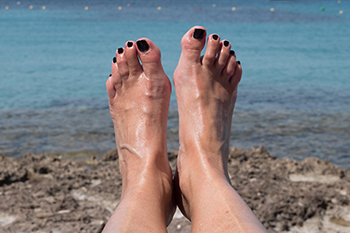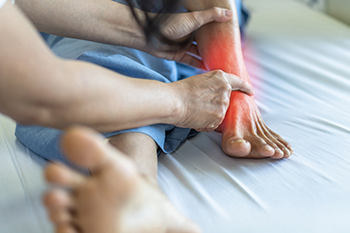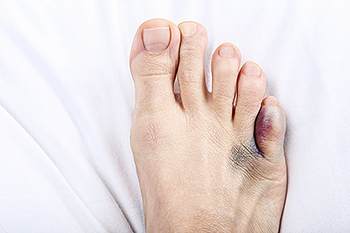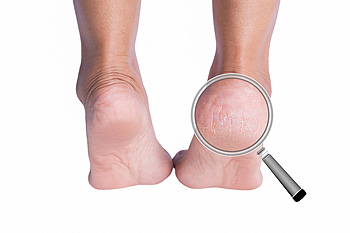July 2022
How Maffucci Syndrome Affects the Feet

There are several troublesome rare diseases that can negatively impact the health of your feet. Although these conditions can be extremely rare, it is important for you to familiarize yourself with these afflictions in case you ever have to identify one of these conditions in yourself or a loved one. One rare condition that negatively impacts the feet is known as Maffucci syndrome, which has only impacted a total of 200 reported patients since its discovery. This syndrome produces a number of abnormalities in the skeleton that can manifest themselves in the feet. For example, people with Maffucci syndrome can experience enchondromas, which are cartilage tumors throughout the bones in their feet. Endochromas caused by Maffucci syndrome can also appear in the hands, ribs, and skull. Individuals suffering from Maffucci syndrome usually also experience some kind of abnormality in the skin. Namely, it is common for individuals to see hemangiomas, or clumps of blood vessels, throughout the skin and possibly on the feet. Maffucci syndrome undoubtedly is a rare condition, but you should be on the lookout for these symptoms. If you are experiencing the above symptoms, or would like to gather more information, it is suggested to speak to a podiatrist.
Some foot conditions may require additional professional care. If you have any concerns, contact John Killough, DPM of Regional Foot Center. Our doctor can provide the care you need to keep you pain-free and on your feet.
Rare Foot Conditions
The majority of foot conditions are common and can be treated by a podiatrist. Standard diagnostic procedures are generally used to identify specific conditions and treatment can be rendered. A podiatrist also treats rare foot conditions which can be difficult to diagnose and may need extra attention and care.
There are many rare foot conditions that can affect children. Some of these can include:
- Freiberg’s disease
- Kohler’s disease
- Maffucci syndrome
Freiberg’s disease - This can be seen as a deterioration and flattening of a metatarsal bone that exists in the ball of the foot. It typically affects pre-teen and teenage girls, but can affect anyone at any age. Symptoms that can accompany this can be swelling, stiffness, and the patient may limp.
Kohler’s disease - This often targets the bone in the arch of the foot and affects younger boys. It can lead to an interruption of the blood supply which ultimately can lead to bone deterioration. The patient may limp or experience tenderness, swelling, and redness.
Maffucci syndrome - This affects the long bones in a child’s foot leading to the development of abnormal bone lesions. They are benign growths and typically develop in early childhood and the bones may be susceptible to breaking.
A podiatrist can properly diagnose and treat all types of rare foot conditions. If your child is affected by any of these symptoms or conditions, please don’t hesitate to call our office so the correct treatment method can begin.
If you have any questions please feel free to contact our offices located in Charleston and Effingham, IL . We offer the newest diagnostic tools and technology to treat your foot and ankle needs.
Tendons in the Ankle That Can Cause Pain

Tendons are tissues that connect bones to muscles. Two such tendons, the peroneal tendons and the posterior tibial tendons begin in the leg and travel down at the rear of the ankle before attaching to bones in the foot. They are instrumental in facilitating certain movements of the ankle and foot. They can also be responsible for causing ankle pain. The posterior tibial tendon connects the muscle in the back of the shin bone to the bones in the foot. This tendon can become injured due to overuse or trauma and cause pain that is felt on the inside of the ankle. The peroneal tendons connect certain calf muscles to the foot. They can become inflamed at the ankle joint behind the fibula bone due to trauma or overuse and cause swelling and tenderness, along with pain behind the ankle. Any kind of ankle pain should prompt a visit to the podiatrist for diagnosis and treatment.
Ankle pain can be caused by a number of problems and may be potentially serious. If you have ankle pain, consult with John Killough, DPM from Regional Foot Center. Our doctor will assess your condition and provide you with quality foot and ankle treatment.
Ankle pain is any condition that causes pain in the ankle. Due to the fact that the ankle consists of tendons, muscles, bones, and ligaments, ankle pain can come from a number of different conditions.
Causes
The most common causes of ankle pain include:
- Types of arthritis (rheumatoid, osteoarthritis, and gout)
- Ankle sprains
- Broken ankles
- Achilles tendinitis
- Achilles tendon rupture
- Stress fractures
- Bursitis
- Tarsal tunnel syndrome
- Plantar fasciitis
Symptoms
Symptoms of ankle injury vary based upon the condition. Pain may include general pain and discomfort, swelling, aching, redness, bruising, burning or stabbing sensations, and/or loss of sensation.
Diagnosis
Due to the wide variety of potential causes of ankle pain, podiatrists will utilize a number of different methods to properly diagnose ankle pain. This can include asking for personal and family medical histories and of any recent injuries. Further diagnosis may include sensation tests, a physical examination, and potentially x-rays or other imaging tests.
Treatment
Just as the range of causes varies widely, so do treatments. Some more common treatments are rest, ice packs, keeping pressure off the foot, orthotics and braces, medication for inflammation and pain, and surgery.
If you have any questions, please feel free to contact our offices located in Charleston and Effingham, IL . We offer the newest diagnostic and treatment technologies for all your foot care needs.
All About Fractures to the Little Toe

Fractures to the 5th metatarsal, or the pinky toe, are quite common. When the fracture occurs in the middle section of the metatarsal, it is known as a Jones fracture. The main cause is sudden force on the outside of the foot. A Jones fracture is common to athletes, dancers, and workers who stand for long periods. Men around 30, who are physically active, and women over 70, who may have osteoporosis, are more likely to sustain a Jones fracture as well. Symptoms include pain, swelling, tenderness, and difficulty walking. Check for discoloration or a bump on the side of the foot that is not usually there. It is not always easy to detect a Jones fracture through an X-ray, and in many cases an MRI or other imaging test may be required. As Jones fractures typically do not heal rapidly, it might take months before you can resume normal activities. If you believe you have sustained a Jones fracture, it’s a good idea to see a podiatrist as soon as possible for an exam and diagnosis.
Broken toes may cause a lot of pain and should be treated as soon as possible. If you have any concerns about your feet, contact John Killough, DPM from Regional Foot Center. Our doctor will treat your foot and ankle needs.
What Is a Broken Toe?
A broken toe occurs when one or more of the toe bones of the foot are broken after an injury. Injuries such as stubbing your toe or dropping a heavy object on it may cause a toe fracture.
Symptoms of a Broken Toe
- Swelling
- Pain (with/without wearing shoes)
- Stiffness
- Nail Injury
Although the injured toe should be monitored daily, it is especially important to have a podiatrist look at your toe if you have severe symptoms. Some of these symptoms include worsening or new pain that is not relieved with medication, sores, redness, or open wounds near the toe.
If you have any questions, please feel free to contact our offices located in Charleston and Effingham, IL . We offer the newest diagnostic and treatment technologies for all your foot care needs.
Are You Suffering From Ingrown Toenails?
Tips to Remedy Cracked Heels

Approximately 20% of all adults in the United States will experience heel fissures, or “cracked heels,” at least once during their lifetime. Cracked heels typically occur when the skin surrounding one’s heel becomes noticeably tough, dry, and thick. The dried skin around the heel can eventually crack, creating fissures. The risk of developing cracked heels is markedly higher during the winter season when the colder weather typically makes the skin drier. If you are experiencing cracked heels, you may be able to make use of several at-home remedies. For example, you may soak your feet in water for approximately 20 minutes and use a pumice stone to gently remove the hardened skin cells. Afterwards, you may apply a heavy-duty moisturizer to the back of your heel. Typically, moisturizers containing ingredients such as petroleum jelly or glycerin can effectively nourish the skin. To address cracked heels, you might also use alpha-hydroxy acids or urea to target hardened skin cells and effectively remove them from your heels. If at-home remedies like these fail to mitigate cracked heels, this could be a sign to consult a podiatrist. Ultimately, cracked heels can be an unsightly annoyance, but you and your podiatrist can take steps to address the affliction.
If the skin on your feet starts to crack, you may want to see a podiatrist to find treatment. If you have any concerns, contact John Killough, DPM from Regional Foot Center. Our doctor can provide the care you need to keep you pain-free and on your feet.
Cracked Heels
It is important to moisturize your cracked heels in order to prevent pain, bleeding, and infection. The reason cracked heels form is because the skin on the foot is too dry to support the immense pressure placed on them. When the foot expands, the dry skin on the foot begins to split.
Ways to Help Heal Them
- Invest in a good foot cream
- Try Using Petroleum Jelly
- Ease up on Soaps
- Drink Plenty of Water
Ways to Prevent Cracked Heels
- Moisturize After Showering
- Skip a Shower
- Keep Shower Water Lukewarm
- Don’t Scrub Your Feet
If you are unsure how to proceed in treating cracked heels, seek guidance from a podiatrist. Your doctor will help you with any questions or information you may need.
If you have any questions, please feel free to contact our offices located in Charleston and Effingham, IL . We offer the newest diagnostic and treatment technologies for all your foot care needs.





